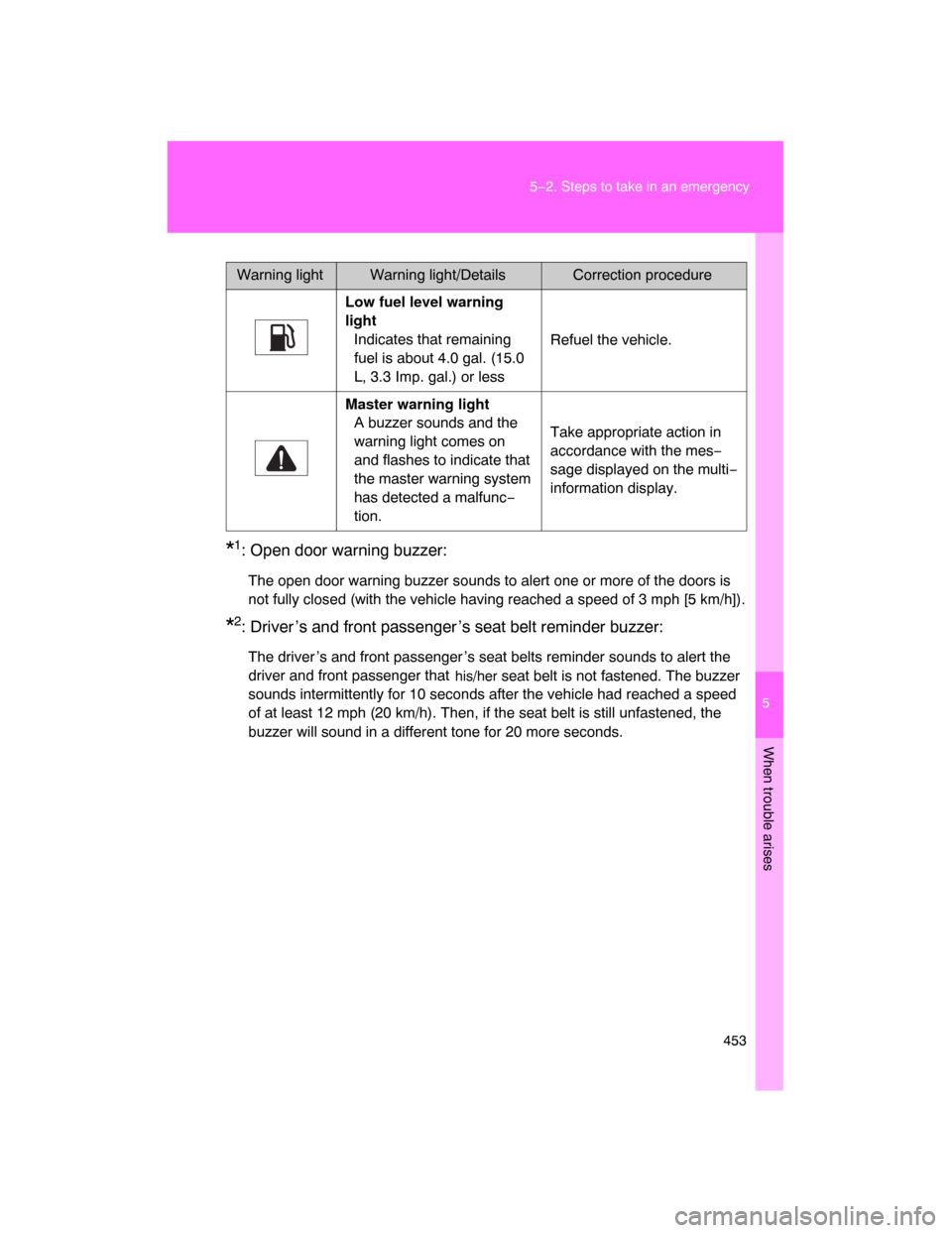Page 446 of 531
452 5−2. Steps to take in an emergency
Warning lightWarning light/Details Correction procedure
Driver ’s seat belt
reminder light (warning
buzzer)
*2
Warns the driver to fasten
his/her seat belt.Fasten the seat belt.
(On the cen−
ter cluster)Front passenger ’s seat
belt reminder light (warn�
ing buzzer)
*2
Warns the front passen−
ger to fasten his/her seat
belt.Fasten the seat belt.
Tire pressure warning
light
When the light comes on:
Low tire inflation pressure.Adjust the tire inflation
pressure.
When the light comes on
after blinking for 1 minute:
Malfunction in the tire
pressure warning system.Have the system checked
by your Toyota dealer.
Unengaged “Park” warn�
ing light
The transmission “Park”
mechanism is not
engaged.Shift four−wheel drive con−
trol out of “N”. (
P. 190)
Page 447 of 531

5
When trouble arises
453 5−2. Steps to take in an emergency
*1: Open door warning buzzer:
The open door warning buzzer sounds to alert one or more of the doors is
not fully closed (with the vehicle having reached a speed of 3 mph [5 km/h]).
*2: Driver ’s and front passenger ’s seat belt reminder buzzer:
The driver ’s and front passenger ’s seat belts reminder sounds to alert the
driver and front passenger that
his/her seat belt is not fastened. The buzzer
sounds intermittently for 10 seconds after the vehicle had reached a speed
of at least 12 mph (20 km/h). Then, if the seat belt is still unfastened, the
buzzer will sound in a different tone for 20 more seconds.
Warning lightWarning light/Details Correction procedure
Low fuel level warning
light
Indicates that remaining
fuel is about 4.0 gal. (15.0
L, 3.3 Imp. gal.) or lessRefuel the vehicle.
Master warning light
A buzzer sounds and the
warning light comes on
and flashes to indicate that
the master warning system
has detected a malfunc−
tion.
Take appropriate action in
accordance with the mes−
sage displayed on the multi−
information display.
Page 448 of 531

454 5−2. Steps to take in an emergency
nIf the malfunction indicator lamp comes on while driving
The malfunction indicator lamp will come on if the fuel tank becomes com−
pletely empty. If the fuel tank is empty, refuel the vehicle immediately. The
malfunction indicator lamp will go off after several trips.
If the malfunction indicator lamp does not go off, contact your Toyota dealer
as soon as possible.
nFront passenger detection sensor and passenger seat belt reminder
lIf luggage is placed on the front passenger seat, the front passenger
detection sensor may cause the warning light to flash, even if a passen−
ger is not sitting in the seat.
lIf a cushion is placed on the seat, the sensor may not detect a passen−
ger, and the warning light may not operate properly.
nSRS warning light
This warning light system monitors the following:
lThe airbag sensor assembly
lFront airbag sensors
lThe curtain shield airbag sensors
lThe side and curtain shield airbag sensors
lThe seat belt buckle switches
lThe driver ’s seat position sensor
lThe inflators
lThe interconnecting wiring and power sources
lThe front passenger occupant classification ECU
l“AIR BAG ON” and “AIR BAG OFF” indicator lights
lThe seatbelt pretensioners
lThe roll sensing of curtain shield airbags off indicator light
nChanging the engine oil
l
Make sure to reset oil change system
Page 449 of 531

5
When trouble arises
455 5−2. Steps to take in an emergency
nWhen the tire pressure warning light comes on
Check the tire inflation pressure and adjust to the appropriate level.
Pushing the tire pressure warning reset switch does not turn off the tire
pressure warning light.
nThe tire pressure warning light may come on due to natural causes
The tire pressure warning light may come on due to natural causes such
as natural air leaks or tire inflation pressure changes caused by temper−
ature. In this case, adjusting the ti
re inflation pressu re will turn off the
warning light (after a few minutes).
nWhen a tire is replaced with a spare tire
The spare tire is also equipped with the tire pressure warning valve and
transmitter. The tire pressure warning li ght will turn on if the tire inflation
pressure of the spare tire is low. If a tire goes flat, even though the flat
tire is replaced with the spare tire, the tire pressure warning light does
not turn off. Replace the spare tire with the repaired tire and adjust the
proper tire inflation pressure. The ti
re pressure warning light will turn off
after a few minutes.
Page 450 of 531

456 5−2. Steps to take in an emergency
nIf the tire pressure warning system is inoperative
The tire pressure warning system
will become inoperati ve in the follow−
ing conditions:
(When the condition becomes normal, the system will work properly.)
lIf tires not equipped with tire pressure warning valves and transmit−
ters are used.
lIf the ID code on the tire pressure warning valves and transmitters is
not registered in the tire pressure warning computer.
lIf the tire inflation pressure is more than 73 psi (500 kPa, 5.1 kgf/cm2
or bar).
The tire pressure warning system may become inoperative in the follow−
ing conditions:
(When the condition becomes normal, the system will work properly.)
lIf electronic devices or facilities us ing similar radio wave frequencies
are nearby.
lIf a radio set at similar frequencies is in use in the vehicle.
lIf a window tint that affects the radio wave signals is installed.
lIf there is a lot of snow or ice on the vehicle, in particular around the
wheels or wheel housings.
lIf non−genuine Toyota wheels are used. (Even if you use Toyota
wheels, the tire pressu re warning system may not work properly with
some types of tires.)
lIf tire chains are used.
lIf the spare tire is in a location subject to poor radio wave signal
reception.
lIf a large metallic object which caninterfere with sign al reception is
put in the luggage compartment.
nIf the tire pressure warning light comes on after blinking for 1
minute frequently
If the tire pressure warning light comes on after blinking 1 minute fre−
quently when the “ENGINE START STOP” switch is turned to IGNITION
ON mode, have it checked by Toyota dealer.
Page 451 of 531
5
When trouble arises
457 5−2. Steps to take in an emergency
CAUTION
n If the tire pressure warning light comes on
Be sure to observe the following precautions. Failure to do so could
cause loss of vehicle control and result in death or serious injury.
lStop your vehicle in a safe place as soon as possible. Adjust the tire
inflation pressure immediately.
lIf the tire pressure warning light comes on even after tire inflation pres−
sure adjustment, it is probable that you have a flat tire. Check the tires.
If the tire is flat, change to the spare tire and have the flat tire repaired
by the nearest Toyota dealer.
lAvoid abrupt maneuvering and braking. If the vehicle tires deteriorate,
you could lose control of the steering wheel or the brakes.
n If a blowout or sudden air loss should occur
The tire pressure warning system may not activate immediately.
Page 452 of 531

458 5−2. Steps to take in an emergency
CAUTION
n Maintenance of the tires
Each tire, including the spare (if provided), should be checked monthly
when cold and inflated to the inflation pressure recommended by the
vehicle manufacturer on the vehicle
placard or tire inflation pressure
label (tire and load information label). (If your vehicle has tires of a differ−
ent size than the size indicated on the vehicle placard or tire inflation
pressure label [tire and load information label], you should determine the
proper tire inflation pr
essure for those tires.)
As an added safety feature, your
vehicle has been equipped with a tire
pressure monitoring system (TPMS−ti re pressure warning system) that
illuminates a low tire pressure telltal e (tire pressure warning light) when
one or more of your tires is significantly under−inflated. Accordingly,
when the low tire pressu
re telltale (tire pressure warning light) illumi−
nates, you should stop and check your tires as soon as possible, and
inflate them to the proper pressure. Driving on a significantly under−
inflated tire causes the tire to overheat and can lead to tire failure.
Under−inflation also reduces fuel effi
ciency and tire tread life, and may
affect the vehicle’s handling and stopping ability.
Please note that the TPMS (tire pressure warning system) is not a sub−
stitute for proper tire main tenance, and it is the driver ’s responsibility to
maintain correct tire pressure, even if under−inflation has not reached the
level to trigger illu
mination of the TPMS low ti re pressure telltale (tire
pressure warning light).
Page 453 of 531

5
When trouble arises
459 5−2. Steps to take in an emergency
CAUTION
Your vehicle has also been equipped with a TPMS (tire pressure warning
system) malfunction indicator to indi
cate when the system is not operat−
ing properly. The TPMS (tire pressure warning system) malfunction indi−
cator is combined with the low tire pressure telltale (tire pressure
warning light). When the system det
ects a malfunction, the telltale will
flash for approximately one minute an d then remain continuously illumi−
nated. This sequence will
continue upon subsequent vehicle start−ups as
long as the malfunction exists. When the malfunction indi cator is illumi−
nated, the system may not be able to detect or signal low tire pressure
as intended.
TPMS (tire pressure warning system) malfunctions may occur for a vari−
ety of reasons, including the installati on of replacement or alternate tires
or wheels on the vehicle that prevent the TPMS (tire pressure warning
system) from functioning properly. Always check the TPMS (tire pres−
sure warning system) malfunction te
lltale after replacing one or more
tires or wheels on your vehicle to ensure that the replacement or alter−
nate tires and wheels allow the TPMS (tire pressure warning system) to
continue to function properly.
NOTICE
n Precaution when installing a different tire
When a tire of a different specification or maker is installed, the tire pres−
sure warning system may
not operate properly.